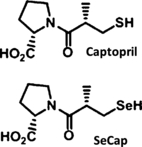Structural characterization of angiotensin I-converting enzyme in complex with a selenium analogue of captopril
- PMID: 21810173
- PMCID: PMC3328747
- DOI: 10.1111/j.1742-4658.2011.08276.x
Structural characterization of angiotensin I-converting enzyme in complex with a selenium analogue of captopril
Abstract
Human somatic angiotensin I-converting enzyme (ACE), a zinc-dependent dipeptidyl carboxypeptidase, is central to the regulation of the renin-angiotensin aldosterone system. It is a well-known target for combating hypertension and related cardiovascular diseases. In a recent study by Bhuyan and Mugesh [Org. Biomol. Chem. (2011) 9, 1356-1365], it was shown that the selenium analogues of captopril (a well-known clinical inhibitor of ACE) not only inhibit ACE, but also protect against peroxynitrite-mediated nitration of peptides and proteins. Here, we report the crystal structures of human testis ACE (tACE) and a homologue of ACE, known as AnCE, from Drosophila melanogaster in complex with the most promising selenium analogue of captopril (SeCap) determined at 2.4 and 2.35 Å resolution, respectively. The inhibitor binds at the active site of tACE and AnCE in an analogous fashion to that observed for captopril and provide the first examples of a protein-selenolate interaction. These new structures of tACE-SeCap and AnCE-SeCap inhibitor complexes presented here provide important information for further exploration of zinc coordinating selenium-based ACE inhibitor pharmacophores with significant antioxidant activity.
© 2011 The Authors Journal compilation © 2011 FEBS.
Figures




References
-
- Ehlers MR, Riordan JF. Angiotensin-converting enzyme: new concepts concerning its biological role. Biochemistry. 1989;28:5311–5318. - PubMed
-
- Unger T. The role of the renin–angiotensin system in the development of cardiovascular disease. Am J Cardiol. 2002;89:3A–9A. - PubMed
-
- Eriksson U, Danilczyk U, Penninger JM. Just the beginning: novel functions for angiotensin-converting enzymes. Curr Biol. 2002;12:R745–R752. - PubMed
-
- Turner A, Hooper NM. The angiotensin-converting enzyme gene family: genomics and pharmacology. Trends Pharmacol Sci. 2002;23:177–183. - PubMed
Publication types
MeSH terms
Substances
Associated data
- Actions
- Actions
Grants and funding
LinkOut - more resources
Full Text Sources
Molecular Biology Databases
Miscellaneous

